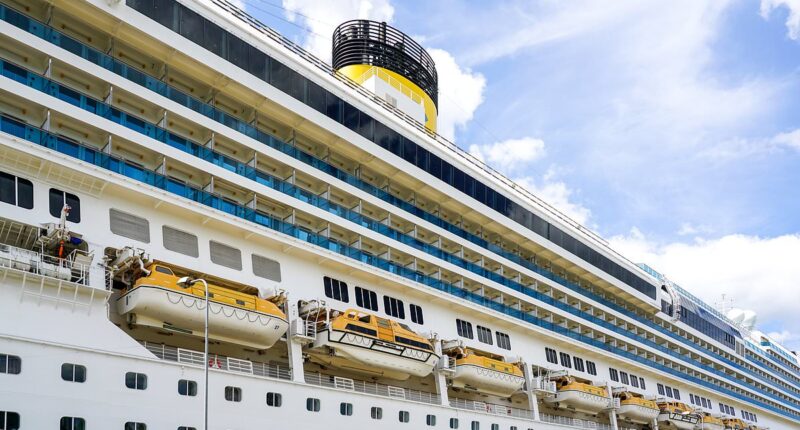Before starting his holiday at sea, a travel expert shared a simple trick that he believes all passengers should adopt. This trick is often overlooked in onboard safety briefings but can be crucial in ensuring passenger safety.
Travel expert Dr Steve Burgess runs CME Vacations, which educates healthcare professionals at conferences held in overseas destinations.
A devoted cruise enthusiast, Dr. Burgess emphasizes a rule that could potentially warn passengers of dangers at sea even before alarm systems are activated. This early warning could provide passengers with valuable extra time to evacuate in case of an emergency.
The medical professional suggests placing a bottle of water near your bed on the floor of your stateroom. This small action can serve as a quick indicator of any issues the ship may be facing, such as entering hazardous waters, smoke, or flooding, allowing passengers to react promptly.
He explained: ‘Most passengers have no idea there’s a simple five-second check they should perform the moment they enter their cruise cabin.
‘Placing a water bottle on your cabin floor isn’t a hydration reminder – it could literally save your life.’
How? The medical doctor says the bottle reflects how the ship is moving, saying: ‘The water in your bottle will react to ship movements that you might not consciously register, especially when you’re sleeping.
‘It serves as an early warning system that could give you precious minutes to react during an emergency.’

A doctor has revealed the one thing he tells fellow medics to do when they board a cruise ship ahead of a holiday – saying it’s a super simple safety trick that could alert tourists early to potential danger

The tip involves placing a bottle of water close to your bed in your cruise stateroom
The signs passengers should look out for include is if the water is ‘sloshing unusually’ or ‘rippling’.
Dr Burgess says it could signify a listing ship or abnormal vibrations, which might mean there’s a mechanical problem with the liner – something which, he adds, could be worth raising with crew to investigate further.
The water bottle might also be able to indicate whether there’s a fire-related emergency; if smoke is seeping into a cabin the bottle is likely to show condensation – another red flag that passengers should be aware of.
Often, smoke can reach a room before smoke alarms detect it, so the water bottle could be the first obvious sign of danger.
The expert says while problems with liners are very rare, the water bottle trick is something he teaches healthcare professionals attending his courses.
He says: ‘It costs nothing, takes seconds to implement, and could provide the early warning that makes all the difference in an emergency.
‘What makes this tip so valuable is that it works while you sleep. Most emergencies at sea happen overnight when passengers are least alert and most vulnerable.
‘Having this passive monitoring system in place gives you peace of mind and potentially crucial extra minutes to respond appropriately.’

Not just for hydration: Dr Burgess says ‘This simple habit has become second nature for experienced cruisers, but it’s almost never mentioned in the safety briefings’
He continues: ‘While cruise ships today are incredibly safe, and serious incidents are rare, being prepared is something we emphasise in medicine – and it applies equally to travel.
‘This simple habit has become second nature for experienced cruisers, but it’s almost never mentioned in the safety briefings.’
Dr Burgess isn’t the only doctor to advise passengers on cruise ship holidays, with one US medic advising against them completely in light of recent federal cuts in the US.
Dr. Rubin, a pediatrician who often shares information about allergies and how to combat them, posted a recent TikTok clip detailing why he won’t be boarding a cruisein the near future.
‘Here’s why you’re not gonna see me on a cruise ship anytime soon, and I encourage people to consider this before they book a cruise,’ he urged in the video.
Dr. Rubin then spoke about the cuts made to federal agencies recently, and how that has impacted overall health and safety checks on the ships.
‘Well one of [the cuts] is to the CDC’s vessel sanitation program, which conducts health inspections on cruise ships at least twice a year and they trace outbreaks to help reduce the chances of more people getting sick,’ he explained.
Dr. Rubin continued saying there has already been 12 norovirus outbreaks on cruise ships so far this year alone, in comparison to eight last year.
‘These cuts make no sense because its not funded by taxpayer dollars,’ he continued.
‘Then cruise ships pay for these health inspections so it’s not like we’re saving any money from the taxpayers perspective,’ the medical professional insisted, before declaring: ‘This makes absolutely no sense.’
The response to Dr. Rubin’s video was divided, with some accusing him of ‘fear mongering.’
‘We cruise every year and just went in mid February, which is prime time for norovirus. We were on Carnival’s biggest ship and were fine,’ one user responded.

Last week, Dr. Rubin (pictured) a pediatrician who often shares information about allergies and how to combat them, posted a recent TikTok clip detailing why he won’t be boarding a cruise

Rubin the spoke about the cuts made to federal agencies recently, and how that has affected the overall health on the ships (stock image)
‘I’m a travel agent and you’re fine,’ declared another.
Other users agreed wtih Dr. Rubin’s assessment.
‘I’m anti-cruise even in normal times. Ships are just one giant Petri dish and it’s a hard pass for me,’ one user wrote.
‘They call Norovirus “cruise ship virus” for a reason,’ someone else chimed in.
‘I caught covid on last one. Never again,’ swore another.
In March, a contagious virus outbreak on the the Coral Princess cruise ship left dozens of passengers and crew ill and in isolation during their nearly three-week-long voyage.
The ship set sail from California on February 21, with 69 of the over 1,000 passengers and 13 of the 895 crew members struck down by norovirus.
Norovirus is a very contagious virus that causes vomiting and diarrhea. It causes acute gastroenteritis, an inflammation of the stomach or intestines, as per the Centers for Disease Control and Prevention (CDC).
The ship was travelling from Los Angeles to Fort Lauderdale, calling at ports along the west coast of Mexico before travelling through the Panama canal into the Caribbean.
According to the CDC, this is the second outbreak of the virus on the cruise liner this year after the Coral Princess reported cases back in January.
Passengers and workers who were struck down were isolated to try and contain the outbreak, public areas were thoroughly disinfected, The New York Post reported.
Last year, was the worst year ever for stomach flu outbreaks on cruise ships in the US.
According to the CDC, there were 16 outbreaks in 2024.
A staggering five of those incidents took place in December 2024 alone – causing 890 cases.
The last time there were that many outbreaks in one year was in 2012.

















